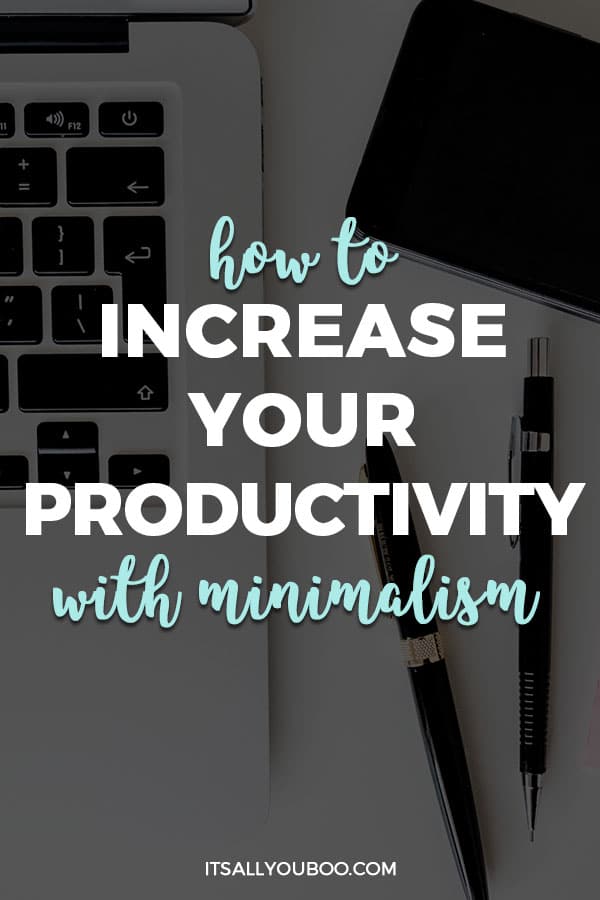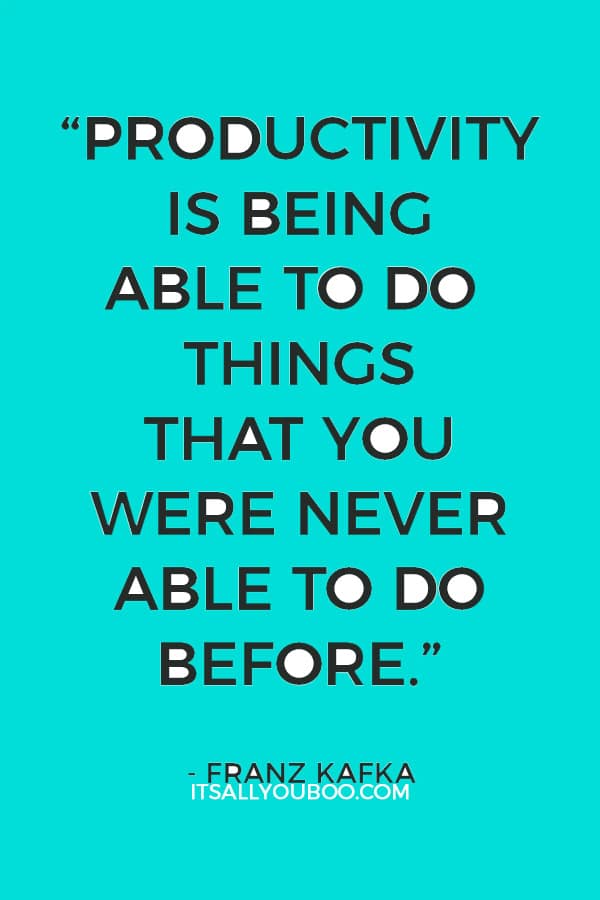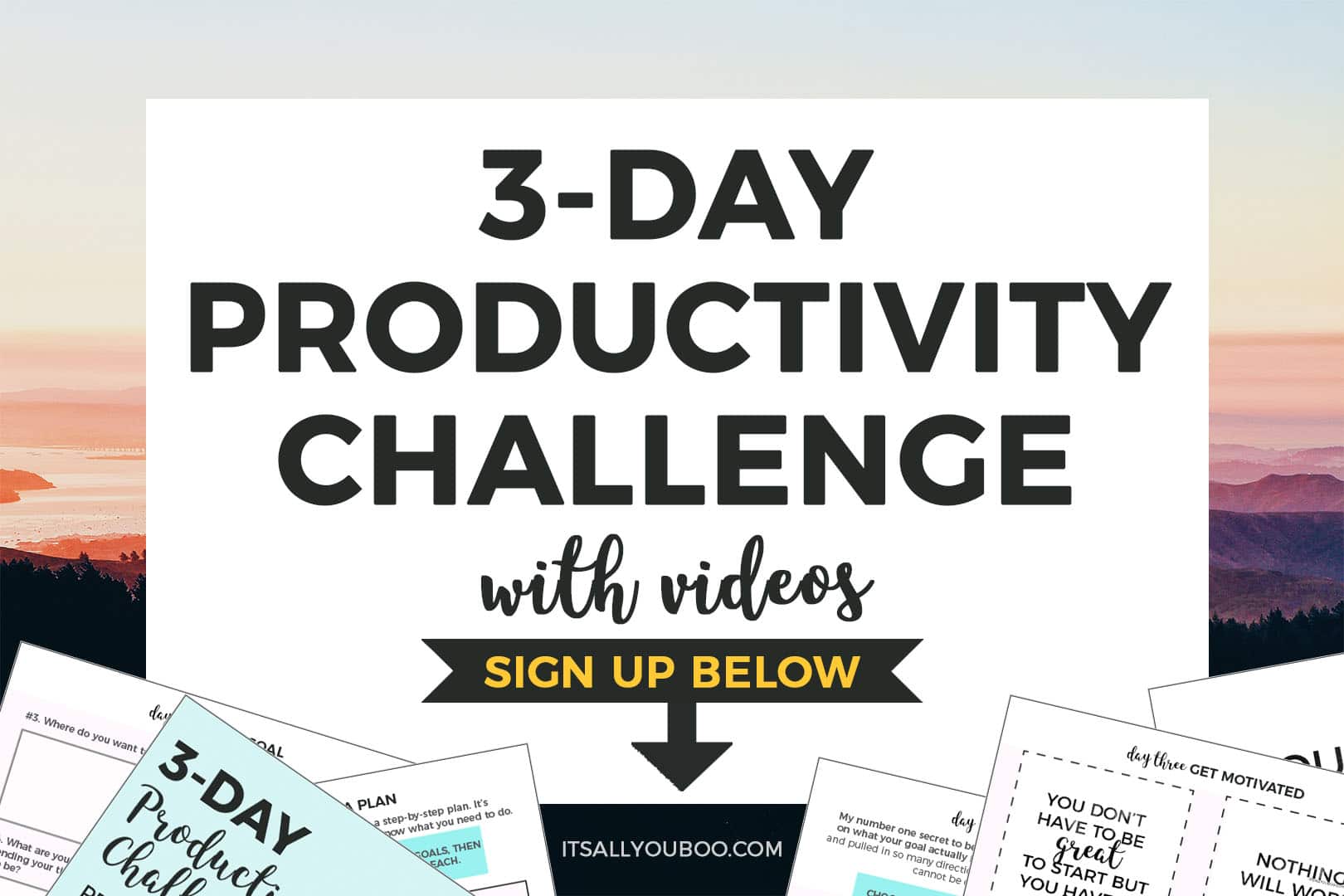How can I become more productive?
Want to increase your productivity? Do you wish you could get more done in less time? Click here to learn the 7 steps to increase your productivity with minimalism. #productivityhack #productivity #minimalism #minimalistLet’s be honest… you’ve looked back at a long workday and the tasks you’ve completed and asked yourself: “Is that it? I thought I did a lot more…”
That’s when disappointment and frustration set in.
You wanted to get so much done, get a big step closer to your goal, but somehow time went by and hardly any of the items on your to-do list are checked off.
You start wondering whether you need to plan more time for your tasks in the future. Maybe getting up another hour earlier will help you get more done?
While this could seem plausible, there’s another point you might have overlooked. Investing more time in your work or project is great. But what’s more important than the amount of time spent is how you use it.
Increasing your productivity is about doing more with less after all, here’s how!
Here are the best minimalist productivity tips and tricks to help you get more done.
THIS POST MAY CONTAIN AFFILIATE LINKS.
IF YOU MAKE A PURCHASE FROM THESE LINKS, I MAY EARN A SMALL COMMISSION.
CLICK HERE FOR MY FULL DISCLAIMER STATEMENT.
How to Increase Your Productivity Instantly with Minimalism
We are often led to believe that the more we do (and plan to do), the better. That’s why we add countless things to our schedule, try to do everything at once and then wonder why projects don’t turn out the way we thought or take way longer to complete than expected.
That’s where minimalism comes to the rescue.
Now you might be thinking: “Wait a minute, minimalism? Isn’t that where you get rid of all your stuff, move to a tiny apartment and stop going on shopping sprees?”
Yes, it can be.
But even without having to purge your house and downsize your wardrobe you can start practicing minimalism and take advantage of its benefits in some areas of your life.
The way you work (both on your personal and professional projects) can be one such area.
What is Minimalism About? And What Does It Have to Do with Increasing Productivity?
Minimalism can look different for different people. Depending on where you are in life, it can take various forms and be practiced in many ways.
In general, practicing minimalism means understanding that more is not always better. Because of that, you’ll find yourself identifying things that don’t add value to your life and slowly getting rid of them. The final goal is to keep only what you need.
Still wondering how that relates to productivity?
If you find yourself constantly adding new things to your to-do list and trying to do it all, minimalism will help you.
By applying the above idea of minimalism to your work habits, you’ll be able to focus on what matters.
👉🏽 RELATED POST: 7 Benefits of Minimalist Living You Need to Know
Eliminating both physical and mental clutter will let you zone in on your mission and evaluate everything based on whether it will help you achieve your goals.
You will learn how to cut unnecessary tasks out of your to-do list, spend less time and energy figuring out what to do next and be able to focus your energy on what’s most relevant to achieving your goals. By doing so you increase your productivity exponentially.
If that sounds like something you want to do, then keep reading…
7 Steps to Increase Productivity by Practicing Minimalism
#1: Start Your Day Right
How you start your day has the biggest impact on how your work will go, so give this one some thought.
The idea here is to keep it simple. When practicing minimalism, your focus is on doing only the things necessary to achieve your goals. Everything else is busy work.
Implementing this when you plan your day can look like this:
- Spend a few minutes making a list of everything that needs to get done
- Pick the top 1-3 things (depending how much time each activity takes)
- Plan when you will do what, giving the most important task priority
With a solid plan for the day, you get started knowing your work will bring you closer to your goal. That will make it easier to keep your focus as you’ll know your tasks are important and can’t be delayed.
👉🏽 RELATED POST: How to Be More Productive and Stop Being Lazy
In the evening, evaluate your progress. Did you finish the things you set out to do? Do you need to continue any of them tomorrow? If yes, put them down as a priority for the next day. You can even decide on the rest of tomorrow’s activities the night before to give yourself a head start in the morning.
Having a strong focus on a few things rather than an endless to-do list will also help you in case life happens and stuff gets in the way. In the likely event of something taking your mind off work for a few hours, you will know how to prioritize your time after the storm has blown over and get back on track.
To maximize this approach’s positive impact and see the bigger picture, plan tasks ahead for the whole week or month.
#2. Work Like a Hermit
If possible and your work allows it, eliminate everything that could be a distraction. This includes the TV, your phone, notifications on your computer and other things around you that could divert your attention from your task.
Need a place to take notes for sudden bursts of inspiration? Use a notebook and a pencil instead of your phone. It works for Warren Buffet, chances are it’ll work for you too.
Sign out of social media, close all those tabs (that’s what bookmarks are for) and get to work.
If your task doesn’t require you to be connected, maybe even shut off the internet. Yes, I actually just said that.
Also, do one thing at a time. Multitasking is an illusion. It does not help you get more stuff done faster. It only slows you down, splits your focus and scatters your brain. Does that sound like a productive state? Not really.
If you do feel an uncontrollable need to check your email for ultra-urgent messages, ask yourself these questions first:
- Will my business die/I get fired if I don’t respond immediately rather than in half an hour?
- Will I lose a client or potential sale if I don’t reply right away?
- What other bad things could happen if I don’t check my messages right now?
Answer these questions honestly and you’ll likely see that you can go off the grid for a while without the world coming to an end.
#3. Batch and Automate
No, we’re not talking about meal prep here. This is about another way of minimizing the number of things you try to do each day and how to best use your time to get stuff done and move towards your goals.
Every job involves some repetitive tasks which need to be done regularly to keep things moving. Often, we break them up into bite-sized pieces, doing a little bit each day or several times a day, depending on the job.
However, that often leads to us losing time that would be better used on something else.
That’s where batching and automation come in. With today’s technological tools, there’s a way to batch or automate many repetitive tasks which will help you free up time for more fun things.
👉🏽 RELATED POST: Why Habit Trackers Inspire Us to Be Better People
Examples of batching tasks:
- Scheduling social media posts instead of doing it every day
- Having two set times a day where you write and reply to emails
- Editing photos and creating artwork for your website
- Doing research on potential clients you want to pitch
Examples of automating tasks:
- Instant auto-replies to emails telling people you’ll get back to them
- Posting to social media (if you scheduled it previously)
- Recording expenses by using accounting software linked to your accounts
Depending on your work, there are many more things you can save time on by batching and automating. Examine your workday, find them and start dealing with them more efficiently.
This will free up your mind and your schedule, giving you more time to do other things that matter.
#4. Keep Everything in One Place
Practicing minimalism means keeping things simple. A great way to implement that in your work is to manage how and where you store your information, notes, ideas, and anything else you want to keep track of.
Often, it’s tempting to try the latest app, get that beautiful new journal and scribble bullets on a random piece of paper whenever inspiration strikes.
And while there’s nothing wrong with jotting down notes or testing a new app, make sure all your important ideas have one common home, so you don’t lose track.
Remember, each of these approaches is supposed to help you stay focused. By using all of them at once, you’re back to square one with a difficult-to-manage mess of notes, sketches, outlines, photos, and other information all over the place.
👉🏽 RELATED POST: How to Project Manage Reaching Your Goals
Looking for a good place to plan your work and keep all your ideas? Here are some suggestions:
- Start a bullet journal
- Use sticky notes
- Try apps like Trello or Asana
- Use your computer’s “notes” app
- Get Evernote for your phone and computer
There are many more options, each with pros and cons. Stick with what works for you and you’ll see how you get more done, simply because you spend less time looking for stuff or to learn a new system every other week and more time working.
#5. Buffering…
While having a good internet connection can play a big part in keeping you productive, that’s not what this point is about.
Rather, it’s a reminder to give yourself a time buffer when planning your day, instead of stuffing every single minute with important tasks.
But why not plan to utilize every moment?
Because stuff happens, and it gets in the way of you checking off the countless items on your list.
If you’re an entrepreneur, you could land a new client with an urgent project. Or if you have a day job, you might have to work late which would cut down the time you can spend on your project.
So, since you never know what will happen tomorrow, or even later that same day, make your schedule flexible by giving it some breathing space.
👉🏽 RELATED POST: How to Quickly Beat Overwhelm with Lazy Goals
That way you can deal with surprises, still finish everything on your list and feel this great sense of accomplishment that comes with a day well spent.
And what if nothing happens and you have extra time? You can get ahead with tomorrow’s tasks or have a little break. After all, if you’ve checked off everything today, you probably deserve a little rest.
That brings us to our next point.
#6. Break It Up
You’ve already narrowed down the number of tasks you want to do in a day. Now you just have to get going and stay productive.
The best way to do that is to break your tasks down into milestones and take a quick breather every time you finish one. Taking breaks gives your brain a chance to relax and refocus and will do wonders for boosting your productivity.
Finding a rhythm that works for you is important here. Some people love working for 25 minutes before taking a five to ten-minute break, others go for 50 minutes of work, and ten minutes of break time. Play around with this one to find what suits you best.
Bonus tip: Not all breaks are created equal. Use them for something truly relaxing. Instead of scrolling through social media or reading emails, do a short mindfulness meditation, some stretching, get a drink of water or even go for a short walk to clear your mind.
#7. Stretch Time, Not Your Work
Have you ever been given a seemingly impossible deadline for a task? And were you able to complete it even though you were convinced you’d run out of time?
If yes, then you’ve experienced the stretchiness of time. It’s the reason why we often take longer to do something if we have more time to do it. If the deadline is closer, you work with more focus and get things done faster.
👉🏽 RELATED POST: 4 Easy Strategies You Need to Beat Procrastination
Next time you feel your productivity waning follow these simple steps:
- Give yourself a short but reasonable deadline
- Plan something important which you can’t postpone right after you’re supposed to be done with your work. That could be lunch with a friend, a call with a client or anything you would feel uncomfortable canceling or being late for.
- Get to work and marvel at how fast you can suddenly get stuff done 🙂
Wondering whether these points will finally help you get more done in the little time you have to work on your project after your day job? Or if it will help you become a more productive, less stressed new entrepreneur?
I know they will.
Take the FREE Productivity Challenge
Ready to increase your productivity? Sign up for the FREE 3-Day Productivity Challenge, with daily video lessons and printable workbook.
Let’s review all we’ve covered in this guide to increasing your productivity. The 7 steps to increased productivity with minimalism are to:
- Start Your Day Right
- Work Like a Hermit
- Batching and Automating
- Keep Everything in One Place
- Buffering…
- Break It Up
- Stretch Time, Not Your Work
But don’t take my word for it. Try it for yourself. Give each of the points above a test run for a few days or maybe even a week and watch as you increase your productivity seemingly all by itself.
At the end of the week, you’ll wonder how in the world you go so much done when it used to be such a struggle.
And I know that’s something you’re dreaming of right now.
So, get started!
How will you increase your productivity?

More About Guest Contributor
Juliana is a health and wellness-loving voyager on a lifelong mission to help people live their best life by adopting a happy, fulfilling, and healthy lifestyle. She currently lives in Vietnam where she’s building her copywriting business and exploring the rich local culture together with her husband.
Last Updated on June 3, 2025












